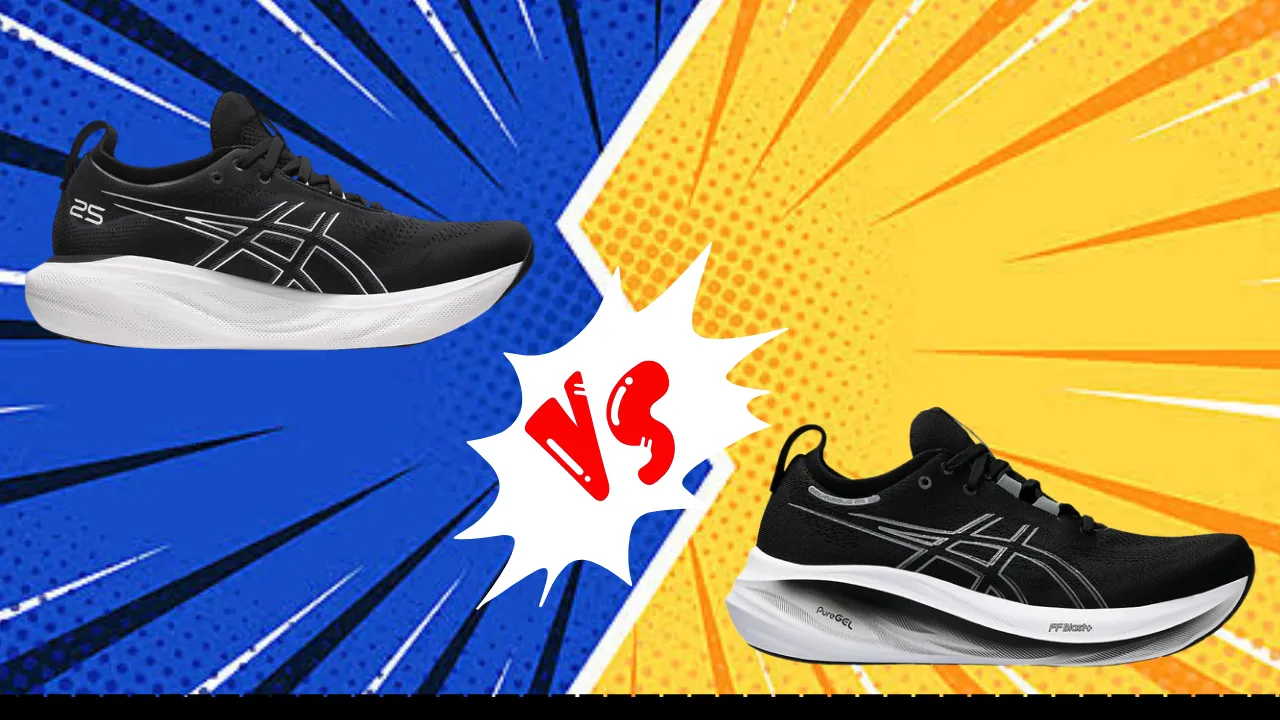The Asics Gel-Nimbus series has been a staple for runners seeking a comfortable, cushioned daily trainer for years.
With the recent release of the Asics Gel-Nimbus 26, runners now have an updated option but may be wondering how it compares to its predecessor, the popular Gel-Nimbus 25.
This comprehensive comparison will highlight the key similarities and differences between the Nimbus 25 and 26 across critical categories like cushioning, fit, weight, price, and more. Whether you’re looking to upgrade to the latest model or trying to decide between the two versions, read on to discover which Asics Gel Nimbus model is better for you.
Similarities And Differences Between Gel-Nimbus 25 And 26:
| Feature | Gel-Nimbus 25 | Gel-Nimbus 26 |
|---|---|---|
| Launched In | 2023 | 2024 |
| Stability | Moderate | Very Much Stable |
| Flexibility | Moderate | Not very flexible |
| Sizing | True to size | Runs true to size |
| Weight | 10.6 oz (M), 9.3 oz (W) | 10.7 oz (M), 9.2 oz (W) |
| Cushioning | High | Moderate |
| Outsole | AHAR® rubber | AHAR+® rubber |
| Midsole | FlyteFoam Propel | FF BLASTTM Plus |
| Upper | Engineered knit mesh | Breathable mesh |
| Retail Price | $160 | $160 |
Features Comparison:
Materials:
The outsoles on both shoes utilize AHAR rubber but the Nimbus 26 has the upgraded AHAR+ formula which provides more durability and traction.


The midsole foams differ with the Nimbus 25 featuring FlyteFoam Propel while the Nimbus 26 has the new FF BLASTTM Plus foam. FlyteFoam Propel has a softer feel but FF BLASTTM Plus is more sustainable.
For the upper, the knit mesh on the 25 offers stretch while the 26 uses an engineered mesh for breathability.
Durability:
Both Nimbus models are built to last, with testers reporting 300-500 miles of use before signs of wear. The outsole rubber compounds play a key role in longevity and the AHAR+ rubber of the Nimbus 26 may give it a slight edge in extending the lifespan.
The FlyteFoam Propel on the 25 compresses over time while the FF BLASTTM Plus on the 26 holds up better.
Fit:
The Nimbus models share a similar true-to-size fit. The knit upper of the 25 conforms closely to the foot for a compression-like feel. The 26 has a smoother interior with less irritation.


Those with wider feet may find the toe box on the 25 too narrow. Trying both models on is recommended to determine personal fit preferences.
Stability:
While designed for neutral runners, both versions provide moderate stability through Asics’ IGS® system with a plastic Trusstic plate. T
he Nimbus 25 gives more substantial guidance while the 26 has only a hint of stability that won’t impede natural motion. Those needing pronation support may want to look at options like the GT-2000 series.
Cushioning:
The Nimbus series is known for its plush cushioning and both models deliver. The FlyteFoam Propel foam of the 25 feels softer underfoot while the FF BLASTTM Plus of the 26 is more responsive. The additional stack height on the 25 adds to the cushioned feel.
Comfort seekers may prefer the pillowy 25 while those wanting a blend of softness and energy return may lean towards the 26.
Value:
With an identical $160 retail price, buyers can’t go wrong with either model in terms of value.
The updates on the 26 make it a slightly better value for runners who prefer the latest technology and materials. However, the proven pedigree of the 25 makes it still worth the investment too.
Performance Comparison;
Walking:
The ample cushioning on both models makes walking in the Nimbus 25 and 26 a luxurious experience. The plush heel ensures a soft landing with each step.
The Nimbus 25 may have a slight edge for all-day walking comfort thanks to its softer midsole while the 26 is not far behind. Those logging serious miles will appreciate the support of either option.
Running:
As neutral daily trainers, both Nimbus models handle moderate-paced runs with aplomb. The energetic FF BLASTTM Plus foam of the 26 gives it a responsive feel over long distances compared to the 25’s softer ride.
The weight savings on the 26 also make it feel nimbler during faster training like tempo runs. The 25 is ideal for easy miles thanks to the pillowy midsole. Long run comfort favors the 25 but speedier efforts lean 26.
Plantar Fasciitis:
Sufferers of plantar fasciitis will benefit from the substantial cushioning and support on both Nimbus models. The heel drop puts less strain on the plantar fascia ligament. The soft landings reduce stress with each step.
Those needing arch support may want an aftermarket insert, but the plush foam eases discomfort. Overall, the Nimbus 25 seems optimal for plantar fasciitis relief thanks to its plusher midsole.
Standing All Day:
Employees who are on their feet all day require a combination of cushioning and support. The Nimbus series delivers both. Standers may appreciate the bouncy FF BLASTTM Plus foam on the 26 for energy return, but the 25’s softer midsole ensures all-day comfort.
The ample forefoot room in both shoes also reduces foot fatigue. For standing-heavy shifts, the Nimbus 25 gets the slight nod for comfort while the 26 works well too.
Final Verdict:
The Nimbus 26 offers incremental updates rather than a dramatic overhaul of this trusted franchise. The lighter materials, smoother upper, and more sustainable midsole give the Nimbus 26 an edge in technology while retaining the series’ signature cushioned ride.
However, runners looking for the softest feel may still opt for the proven Nimbus 25. Both remain cushioned daily trainers suitable for neutral runners and can work well for your needs.

